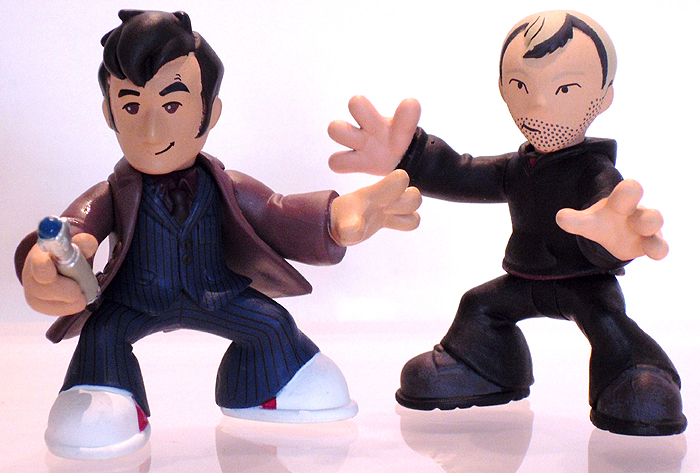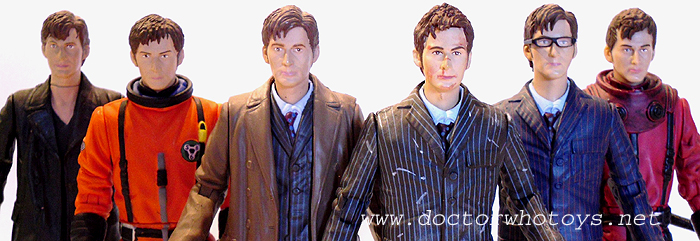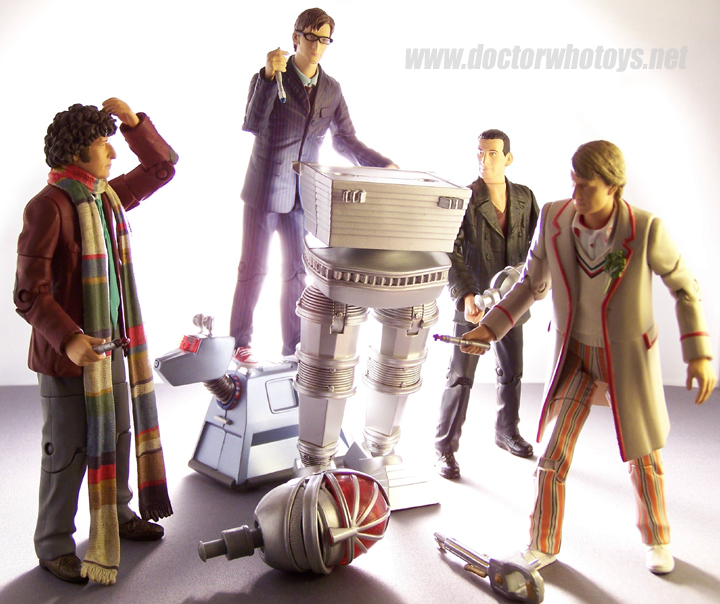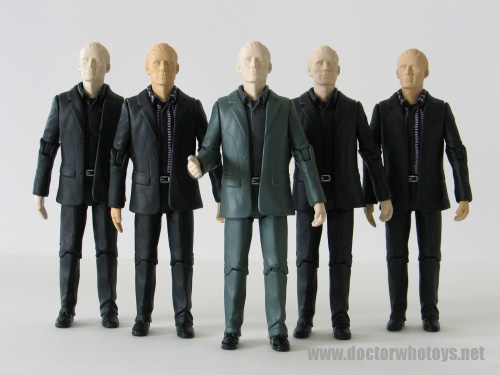Professor Cathy Carey
On the Economics & Psychology of Collecting Behaviour
Exclusive Interview with Professor Cathy Carey
Economist, Academic, Writer & MoC Action Figure Collector
This interview is Strictly Copyright © doctorwhotoys.net, All Rights Reserved; may not be reproduced in full or part.
Dr Cathy Carey PhD is Economics & Marketing Professor at Western Kentucky University. Dr Carey specializes in the fields of Industrial Organization, Monetary Economics and E-Commerce Economics. Author of “Modeling Collecting Behavior: The Role of Set Completion” in the Journal of Economic Psychology (2007), she is interested in the motivations of collectors and the role of the toy industry in the creation of collectibles markets. Carey is the Editor of the Journal of Applied Economics and Policy.

"Collect Them All!"
 Is the will to collect present in everyone or in particular types of people at particular times in their lives?
Is the will to collect present in everyone or in particular types of people at particular times in their lives?
 It's difficult to say, but my instinct tells me that everyone collects something. I asked my mother once if she would define herself as a collector. She said that no, she doesn’t really collect anything. But the substantial quantities of bird pictures, antiques, wash basins, and garden gnomes around the house suggested otherwise
It's difficult to say, but my instinct tells me that everyone collects something. I asked my mother once if she would define herself as a collector. She said that no, she doesn’t really collect anything. But the substantial quantities of bird pictures, antiques, wash basins, and garden gnomes around the house suggested otherwise
The problem with measuring the incidence of collecting behavior lies in measuring just what a collectible is. For example, looking at the single category of “toys” doesn’t tell us which toys are collectible
Another problem is that almost anything can become a collectible. I have read of bizarre collections such as airline sickness bags and sugar packets. (Although, some sugar sellers encouraged the practice by creating sets – such as putting U.S. Presidents on the packages.) I also suspect that life circumstances (changes in income, living space, family status, etc.) affect the timing of when someone might collect or the nature of their collection.
Have people always collected things?
I’ll leave this one to the historians. I suspect the answer is "yes"...

Timesquad 10th Doctor with Collect & Build Timesquad Master
Why might children collect toys?
Kids like to play with toys. They value toys for their entertainment value. They might want all of the characters in a set to have more complete role play. It’s more difficult to plunge into an imaginative world of Star Wars with only the Luke character and one fighter jet.

Why do some adults collect toys?
An older survey conducted by Digital Marketing Services, Inc (reported in Mouse Potatoes, 2002) found that toy collecting was the fourth ranked collectible of adults in the U.S. over the age of 18
A collectible will have many, if not all, of the following characteristics: aesthetic value, standardization, authentication, variation, set completion, nostalgia/noteriety/novelty, affordability, rarity, investment value, community, and a thrill of the hunt. Any one or more of these characteristics will bring out the collector in an adult or child. In all likelihood, the collectible toy reminds them of something from their childhood or a favorite movie or tv show, etc.
Doctor Who toys appeal to the fans of the television show or fans of science fiction in general. Doctor Who has a long history – many adults grew up with the show and many new fans will be seeking collections for historical value as well.

Why do some collectors want a complete set, and others not?
It just depends on the collector’s tastes, preferences, and his budget.
What might a collection of unopened toys say about the person who collected them?
To understand this, we would need to know the difference between a collector and a noncollector.
A noncollector would not value an addition to a collection any differently than the value of that addition in ordinary use. A collector, on the other hand, would value an addition to a collection for its ordinary use and for its contribution to the collection. For example, a noncollector may purchase more than one clock for her home. Additional clocks are handy, but being able to determine the time is of most value. Too many clocks are simply clutter. A collector of clocks, however, may purchase additional clocks for her home and place value on the additional clock for its time keeping function, as well as, for its contribution to the collection. It is also possible that the collector may value an addition to the collection more for its contribution to the collection than for its value in ordinary use - enough so that the collector removes the good from its ordinary use
Adult toy collectors are less likely than children to place value on the ability to “play” with a toy. This explains why people might not open toys for fear of damaging them or reducing their monetary or social value, or why they might buy duplicates of a collectible – one to open and one to add to the collection.

Do manufacturers of collectibles consciously use an awareness of set completion behavior for commercial purposes?
I can’t say for sure about the intentional motives of collectibles manufacturers. I can only observe what they do and suggest that they have a plan
Collectible toys have what we call, in economics, “consumption externalities”. In other words, people often collect to complete a set of related items. This set may be to have all characters in a movie, all cars of a particular NASCAR driver, etc. Or they may simply want to fill a shelf on the wall. In this sense, a complete set is more valuable than the sum of each individual piece by itself. Manufacturers capitalize on this by keeping set sizes manageable and by short packing pieces of the set so that the short packed pieces are more “rare” than the others. Or they may produce the same amount of each character and let supply and demand determine the nature of shorted items.

Are mass marketing campaigns used to foster the desire to collect?
Of course. The popular slogan “Collect them all” is designed to capitalize on the behavior suggested above. If people are aware of all of the possible alternatives, those that have the natural desire to complete sets will begin on a personal campaign. There are several strategies that I have observed.
One is to short pack some items in the set. In other words, they do not package all of the pieces of the set in the same proportions when shipping them to the retailers.
Another strategy is to price to the noncollector and then make purchasing more random. I like to call this the “gumball” strategy. I have witnessed adult collectors purchasing an excessive amount of toy collectibles from gumball machines because the collector is willing to pay a premium through buying extras of the oversupplied variation in order to collect the entire set of variations from the machine. This is a similar strategy to Cracker Jacks and cereal box toys.

Why do people like to identify with certain brands, such as Doctor Who, and why might this be repeatedly expressed through consumption of branded merchandise?
Collectors will want to specialize in a particular character or brand to keep their collections more specific to their own preferences and to establish limits that fit within their own budgets or guidelines.
What benefits can people derive from collecting?
Collectors are often associated with the investment value of their collections. For example, some collect coins or arrow heads or guns because they are expected to rise in value. But most collections are not collected for the purpose of selling. For example, people collect magnets or thimbles to remind them of trips they have taken. Some just find the things they collect aesthetically pleasing. For example, they might have a preference for “bird” pictures and therefore buy several matching or related pictures to hang in a room. Some learn from their collections (e.g., stamps, Presidential dollars or state quarters). Some collect for the benefit of the social interactions – discussion boards, blogs, conventions, etc. There are many benefits from collecting.

Is there a point at which collecting could become problematic for an individual?
It becomes problematic if individuals begin sacrificing other values in life for the sake of the collection. For example, perhaps allocating too much of their budgets for a coveted collectible, running out of places to store the collectibles, or sacrificing time with loved ones to nurture their collectibles. At other times, circumstances just change, such as a lost job or a move
I have a large collection of action figures that are packaged in boxes in the attic. They used to decorate the walls of my office in our old house. Given that my office is now a front room in our new house, I thought it might be rather gaudy to cover the walls. But I can’t bring myself to get rid of them. (Yet).
These problems will vary in intensity with different collectors. Some collectors may be viewed as eccentric based on their collections. They will often view this as a badge of honor.
Thanks Cathy
Images © Hoosier Whovian, Cameron & Cyberlek. Interview Copyright © doctorwhotoys.net, All Rights Reserved; may not be reproduced in full or part
10,000 words & 63 exclusive BBC approved images: The Story of Doctor Who Action Figures Read It Now Thanks Ed
Interviews
Designworks
History
Classics
5" Figures
News
Forum
Content is copyright © doctorwhotoys.net













